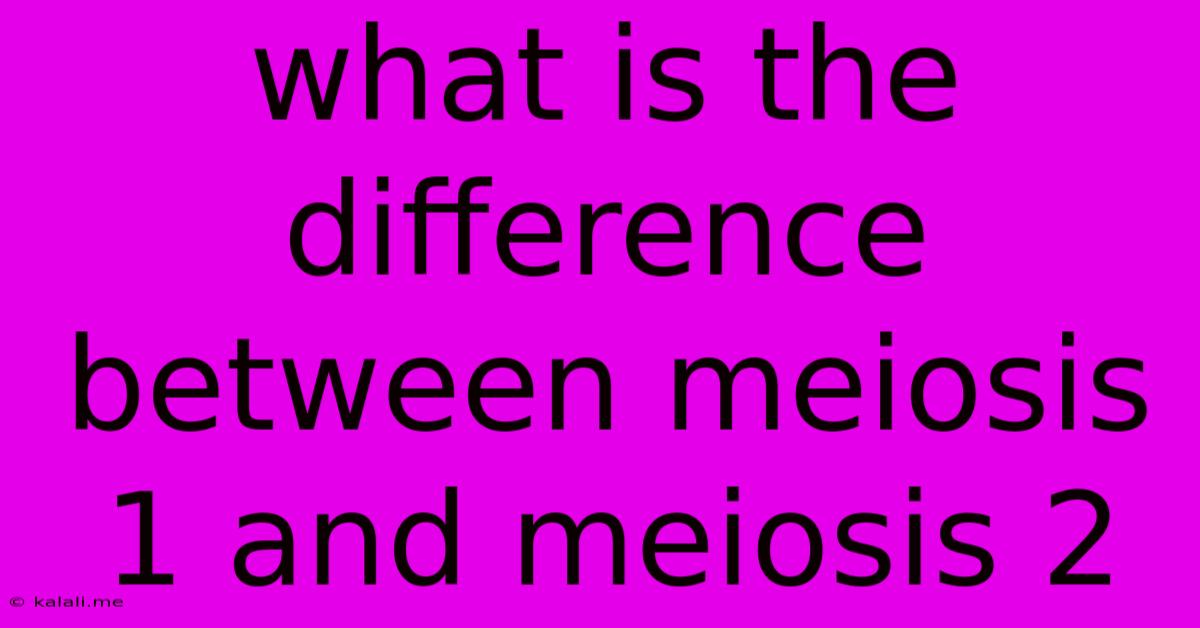What Is The Difference Between Meiosis 1 And Meiosis 2
Kalali
May 10, 2025 · 3 min read

Table of Contents
Meiosis I vs. Meiosis II: A Detailed Comparison
Meiosis is a specialized type of cell division that reduces the chromosome number by half, creating four haploid cells from a single diploid cell. This process is crucial for sexual reproduction, ensuring genetic diversity in offspring. Meiosis is divided into two successive divisions: Meiosis I and Meiosis II. While both involve similar phases (prophase, metaphase, anaphase, telophase), significant differences exist, leading to distinct outcomes. Understanding these differences is key to grasping the intricacies of sexual reproduction and inheritance.
What is Meiosis? A quick overview
Before diving into the specifics of Meiosis I and II, let's briefly recap the overall purpose of meiosis. Diploid cells (containing two sets of chromosomes, one from each parent) undergo meiosis to produce haploid gametes (sex cells like sperm and eggs) with only one set of chromosomes. This halving of chromosome number is essential because fertilization—the fusion of two gametes—restores the diploid chromosome number in the zygote (fertilized egg). Without this reduction, chromosome numbers would double with each generation.
Meiosis I: The Reductional Division
Meiosis I is the critical stage where the chromosome number is halved. This is achieved through a unique process of homologous chromosome separation. Let's examine the key distinctions:
-
Prophase I: This is the longest and most complex phase. Homologous chromosomes pair up, forming bivalents or tetrads. Crossing over occurs—a crucial event where non-sister chromatids exchange genetic material, leading to genetic recombination and increased genetic diversity.
-
Metaphase I: Bivalents align at the metaphase plate, with homologous chromosomes positioned randomly on either side. This independent assortment of homologous chromosomes contributes significantly to genetic variation in offspring.
-
Anaphase I: Homologous chromosomes separate and move towards opposite poles. Sister chromatids remain attached at the centromere. This is the defining characteristic of Meiosis I, as it's the separation of homologous chromosomes, not sister chromatids.
-
Telophase I & Cytokinesis: Two haploid daughter cells are formed, each containing one chromosome from each homologous pair. However, each chromosome still consists of two sister chromatids.
Meiosis II: The Equational Division
Meiosis II resembles a mitotic division, but it acts upon haploid cells. The key difference lies in the starting material: Meiosis II begins with haploid cells, while mitosis begins with diploid cells.
-
Prophase II: Chromosomes condense again.
-
Metaphase II: Chromosomes align at the metaphase plate, individually this time, not as pairs.
-
Anaphase II: Sister chromatids separate and move to opposite poles. This is similar to the anaphase stage in mitosis.
-
Telophase II & Cytokinesis: Four haploid daughter cells are produced, each genetically unique due to crossing over and independent assortment in Meiosis I.
Key Differences Summarized:
| Feature | Meiosis I | Meiosis II |
|---|---|---|
| Chromosome Number | Reduces chromosome number by half | Maintains chromosome number |
| Homologous Chromosomes | Separate | Do not separate |
| Sister Chromatids | Remain attached in Anaphase I | Separate in Anaphase II |
| Genetic Variation | High (crossing over & independent assortment) | Low (no crossing over, but still independent assortment) |
| Outcome | Two haploid daughter cells | Four haploid daughter cells |
In Conclusion:
Meiosis I and Meiosis II are distinct yet interconnected stages vital for sexual reproduction. Meiosis I, the reductional division, is responsible for halving the chromosome number through the separation of homologous chromosomes. Meiosis II, the equational division, separates sister chromatids, resulting in four genetically diverse haploid cells. Understanding these differences is fundamental to comprehending the mechanisms of inheritance and the incredible diversity of life.
Latest Posts
Latest Posts
-
How Many Times Does 6 Go Into 100
Jun 30, 2025
-
What Is 453 605 Rounded To The Nearest Thousand
Jun 30, 2025
-
How Many Grams Is A Kilo Of Coke
Jun 30, 2025
-
How Many Tablespoons In A Packet Of Hidden Valley Ranch
Jun 30, 2025
-
How Many Bunnies Are There In The World
Jun 30, 2025
Related Post
Thank you for visiting our website which covers about What Is The Difference Between Meiosis 1 And Meiosis 2 . We hope the information provided has been useful to you. Feel free to contact us if you have any questions or need further assistance. See you next time and don't miss to bookmark.